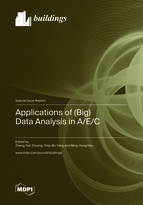Applications of (Big) Data Analysis in A/E/C
A special issue of Buildings (ISSN 2075-5309). This special issue belongs to the section "Construction Management, and Computers & Digitization".
Deadline for manuscript submissions: closed (15 March 2023) | Viewed by 17991
Special Issue Editors
Interests: OR (methods/applications); computer science (CS); (big) data analytics; goal programming; DDDM (data-driven decision making); supply chain decisions; transportation; building information
Interests: structure health monitoring; structure vibration analysis; structural detection and strengthening
Interests: vibration analysis; power systems; electromechanical integration; structural health diagnosis and systems; smart grids; wind power; photovoltaics
Special Issues, Collections and Topics in MDPI journals
Special Issue Information
Dear Colleagues,
This Special Issue (SI), entitled “Application of (Big) Data Analysis in A/E/C”, in Buildings has issued a call for papers. The Special Issue will focus on quality papers outlining novel contributions of the application of big data theory, modelling techniques, and methodologies as a tool for leveraging data analytics in the building industry. Contributions are also welcomed from related topics covering various application domains of the global A/E/C (architecture, engineering, and construction) industry, including, but not limited to, construction management (including building information, land use, etc.), structure engineering and health, materials, transportation management and facilities, and geotechnical engineering. Research involving or utilising theory and modelling methodologies during one, some, or all phases of data collection, data preprocessing, data analysis, prediction, and the decision support functions of the (big) data analysis process are welcomed. In addition to the papers with valuable insights and expressing novel ideas, data-relevant studies that demonstrate advancements in current methodologies or methodological processes for a specific application domain will also be considered.
Dr. Zheng-Yun Zhuang
Dr. Ying-Wu Yang
Prof. Dr. Ming-Hung Hsu
Guest Editors
Manuscript Submission Information
Manuscripts should be submitted online at www.mdpi.com by registering and logging in to this website. Once you are registered, click here to go to the submission form. Manuscripts can be submitted until the deadline. All submissions that pass pre-check are peer-reviewed. Accepted papers will be published continuously in the journal (as soon as accepted) and will be listed together on the special issue website. Research articles, review articles as well as short communications are invited. For planned papers, a title and short abstract (about 100 words) can be sent to the Editorial Office for announcement on this website.
Submitted manuscripts should not have been published previously, nor be under consideration for publication elsewhere (except conference proceedings papers). All manuscripts are thoroughly refereed through a single-blind peer-review process. A guide for authors and other relevant information for submission of manuscripts is available on the Instructions for Authors page. Buildings is an international peer-reviewed open access monthly journal published by MDPI.
Please visit the Instructions for Authors page before submitting a manuscript. The Article Processing Charge (APC) for publication in this open access journal is 2600 CHF (Swiss Francs). Submitted papers should be well formatted and use good English. Authors may use MDPI's English editing service prior to publication or during author revisions.
Keywords
- construction
- engineering
- architecture
- (big) data analytics
- structural health/monitoring
- geotechnical/materials
- power/transportation systems
- data curation and (pre-)processing
- data analysis
- prediction/forecasting
- data-driven decision making








